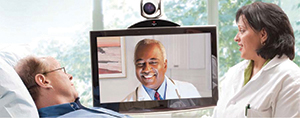HOME | ABOUT US | MEDIA KIT | CONTACT US | INQUIRE
HOME | ABOUT US | MEDIA KIT | CONTACT US | INQUIRE
Advances in telemedicine and telehealth allow hospitals in Kansas City to extend their reach to more patients across the bi-state region.

The Kansas City region’s reputation as a health-care magnet is well established. And the pull of that magnet is increasing, thanks to advances in technology that now allow physicians to treat more patients—for more conditions—from Cape Girardeau to Dodge City. And all from right here.
Telemedicine may be more than two decades old as a concept, but improved visual and diagnostic tools have increased its range of applications, say experts in the field, allowing faster delivery of services, at potentially lower costs, with reduced stress on patients who used to travel hundreds of miles to see physicians.
“It really has changed very rapidly the past couple of years, and the reason is the smart device, smart phones, iPads and so on,” said Ryan Spaulding, associate vice chancellor for community engagement at the University of Kansas Medical Center. He also serves as director of Center for Telemedicine and Telehealth, where he’s also seen growth in other applications.
“A lot of telemedicine involves video interaction, and we still do that, but what’s really gaining momentum is the wearable, sensor-type, remote monitoring,” he said. While that may not be necessarily interactive, he said, those devices send data to either the patient, provider or both. “So those applications will monitor heart rates, or have data that can be sent as a file to a physician or provider,” Spaulding said.
One of the most promising advances has come by applying new technology to stroke treatment, no small consideration for a facility that serves a largely rural state.
“Where it really does make a dif-ference and is expanding rapidly is stroke care,” Spaulding said. “A stroke patient only has about four hours to be seen by neurologist and be given a drug that dissolves that clot,” he said. “That’s hard to do in rural areas. With stroke treatment, not just the clinical aspects, but the financial and economic benefit is very profound. When that patient gets that TPA, in many cases, the stroke is completely reversed.”
Telehealth has paid off extensively for the Veterans Administration, which treats former members of the military from a wide region, said James Sanders, chief medical officer at the VA hospital in Kansas City. “We expand the concept of telemedicine to include all aspects of ‘virtual medicine,’ ” he said. Among those are typical telemedicine encounters with video-conferencing systems, secure messaging with electronic medical records, “e-consults” between primary care providers and specialists, and a nationwide tele-radiology network, which provides back-up for after-hours interpretation of X-rays, to cite just a few.
“Our goal is to improve both access and efficiency, and reserve face-to-face clinical encounters for the situations in which it is really necessary or a patient to drive to the medical center or clinic—whether they live in town or hours away.” Sanders said. As an organization, the VA has set a goal to have 25 percent of its patients use some form of virtual care this year.
Junping Yang, an endocrinologist for Heartland Health in St. Joseph, likened advances in telemedicine to modern sports broadcasting. “With the video quality, you can hear and see the patient much better now,” he said. “Originally, through Missouri Health Net, it was like old TV technology, but now high definition and better audio, it’s almost like the difference between a real game—you can see it better on TV and follow the ball better.”
Heartland’s use of telemedicine, he said, allowed it to reach further into rural areas from its base on the periphery of the broader metropolitan area. “Now, patients can go to a local clinic where the equipment is available, and get close to the same level of care as with an in-patient visit,” he said. “We’re using this in Albany and Bethany, then moving with it into Iowa, North Kansas City, Atchison and Cameron.”
Laura Fitzmaurice, chief medical information officer for Children’s Mercy Hospitals and Clinics, said the range of illnesses and diseaeses not served by telemedicine was declining rapidly. “There are very few, if any, medical specialties that cannot benefit from the incorporation of some type of remote presence solution,” Fitzmaurice reported. Cancer cases might still require a hands-on physicians’s diagnosis, but “even with these cases, a pediatric oncologist can work remotely with a healthcare provider who is trained in that type of assessment,” she said.
Studies have shown that some families actually prefer to receive such a diagnosis by telemedicine in their community, rather than hearing it in person at a major medical center,” Fitzmaurice said. “The real comfort,” she said, “comes from those whom the patient knows, which is not the health-care team the family has only recently met.”